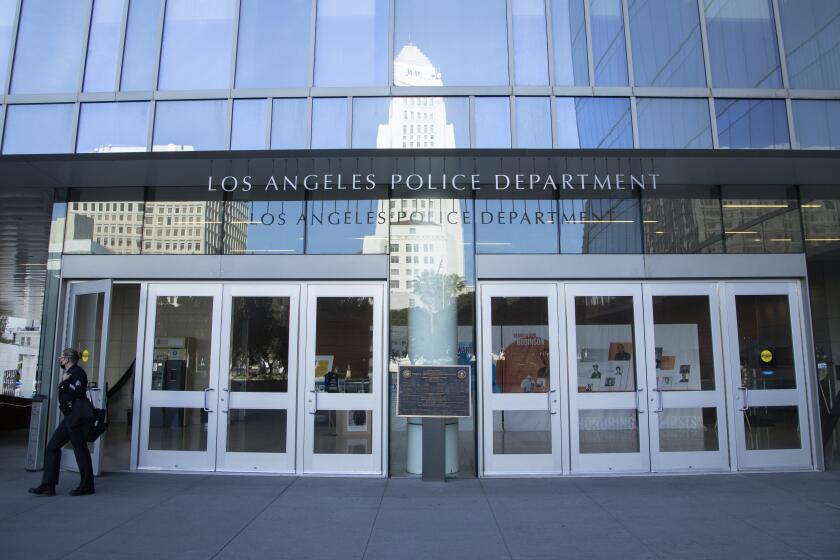San Diego Tracks Its Trash, Sees Savings
With the help of a new computerized global positioning system, the San Diego Environmental Services Department has streamlined the city’s trash pickup routes, lowered dangerous gas emissions and saved thousands of dollars a day in diesel fuel.
City officials say they have cut $671,000 in costs through the rerouting program started a year ago, and they anticipate the savings will increase to $1 million annually as the overhaul expands.
“This system is a lot more efficient now, and it costs the general fund less money,” said Elmer Heap, director of the Environmental Services Department.
Using Internet-based mapping software, the new technology has aided the city in rerouting more than 180 garbage and recycling trucks by concentrating previously scattered trash pickups into compact geographic areas. Workloads, which varied widely in the past, were redistributed to curb overtime costs and reduce employee rivalries for coveted routes -- ones with more overtime. “Before, drivers would say, ‘Drivers who are friends of supervisors get more favorable routes ... and more overtime,’ ” said Nader Tirandazi, an administrator with the Environmental Services Department. “Now, we require drivers to perform at the same level, without favoritism.”
Initially, the new program was used to spot inefficiencies in pickup routes, but it is now used by managers to see where all of the city’s trucks and drivers are at any given time, how fast they are moving and whether they missed a trash bin.
Organized labor was reluctant at first to support the new system because of its potential for use to discipline employees, but it approved of the rerouting effort after the city offered $1,000 merit bonuses to employees.
“GPS is so commonly used now in the private industry ... UPS uses it,” said Joan Raymond, president of the American Federation of State, County and Municipal Employees, Local 127, which represents the city’s trash collectors. “We’ve always argued against it, but we haven’t been able to keep it from the city of San Diego.”
Perhaps unintentionally, the new system also created a potential buffer for the city against costly lawsuits, and has protected employees from false accusations by the public.
“Sometimes a customer will call to say one of our trucks was speeding ... but after running GPS we’d find the truck was going at 20 miles per hour,” said Lyn Eastlick, a safety and training supervisor with the Environmental Services Department. “This is a permanent record ... that really works for us.”
Trash collection has always been a controversial issue in San Diego, but it began to heat up in the mid-1990s after the county sold most of its trash collection services, including money-generating landfills, to the private sector. Although a handful of private trash haulers charge residents for collection -- mostly businesses and apartments -- San Diego does not. As a result, the department has been under pressure to be frugal and utilize technology that is less expensive.
“Part of the reason [San Diego] is a success story is because they have no fee,” said Carolyn Chase, political committee chairwoman of the Sierra Club’s San Diego chapter. “To a certain level, departments realized early on they had to rein costs in.”
The city was one of the first to use satellite technology to map its routes in Southern California.
Although most praise the city’s effort, even the city acknowledges that it will hardly solve San Diego’s biggest problem: running out of space in Miramar, the only landfill operated by the city. Recycling, advocates say, is the city’s best way to avoid losing Miramar, which takes in 1.4 million tons of trash per year and is expected to reach capacity in 2012. “They’re great waste managers in San Diego, but they need to get away from dumping,” said Rick Anthony, a recycling consultant. “That’s so 1995. We’re in 2005.”
In 2002, the year for which the most recent official statistics were available, San Diego had a diversion rate -- disposing of trash through other means than by sending it to landfills -- of 44%, six points below state recycling mandates. By comparison, cities such as Los Angeles and Sacramento -- both municipally run operations -- diverted 62% and 57% of their trash from their landfills, respectively. San Francisco, which pays a private company to collect its refuse, had a diversion rate of 59% that year.
“Among large cities in the state, San Diego has been a laggard in recycling,” said Mark Murray of Californians Against Waste, a nonprofit that advocates for the expansion of recycling services. “The city has always claimed it didn’t have the money to do the [recycling] job right ... but I think part of this has to do with a lack of political will to come up with creative ways of financing it.”
Despite the criticism, trash collection has been rated among the best five city services in annual citizen surveys.
Bonnie Conwell of Mira Mesa said a friendly staff and consistent trash pickups have made her come to trust her trash collectors. “The machinery operates well,” she said. “It’s kind of impressive how they do it [collect trash]. It’s like an assembly line. The cans are usually left exactly where they were the day before.... But as usual, when things go right, no one notices.”
More to Read
Start your day right
Sign up for Essential California for news, features and recommendations from the L.A. Times and beyond in your inbox six days a week.
You may occasionally receive promotional content from the Los Angeles Times.






